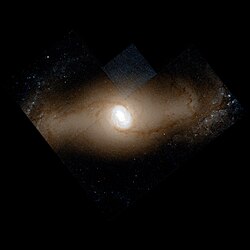Top Qs
Timeline
Chat
Perspective
NGC 1433
Galaxy in the constellation Horologium From Wikipedia, the free encyclopedia
Remove ads
NGC 1433 (also known as PGC 13586) is a barred spiral galaxy with a double ring structure located in the constellation of Horologium. It was discovered by James Dunlop on 28 September 1826,[5] and lies a distance of 46 million light-years from Earth.[4]
NGC 1433 is a Seyfert galaxy with an active galactic nucleus. The central region of the galaxy displays intense star formation activity, with an irregular star-forming ring of 5″ (or 0.3 kpc) radius and weak radio wave emission. Star formation is also noticeable in the spiral arms but not the bar of the galaxy.[6] NGC 1433 is being studied as part of a survey of 50 nearby galaxies known as the Legacy ExtraGalactic UV Survey (LEGUS).[7] A jet of material flowing away from the central black hole of the galaxy extending for only 150 light-years has been found. It is the smallest molecular outflow ever observed in a galaxy beyond our own.[8]
One supernova has been observed in NGC 1433. SN 1985P (type II, mag. 13.5) was discovered by Robert Evans on 10 October 1985.[9][10][11]
NGC 1433 is member of the Dorado Group.[4][12]
Remove ads
Gallery
- LEGUS, optical.[8]
- Hubble Space Telescope, optical.
- STSci DSS, optical.
- James Webb Space Telescope, MIRI; compass.
References
External links
Wikiwand - on
Seamless Wikipedia browsing. On steroids.
Remove ads





